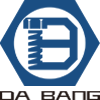The standard values of 4.8 and 8.8 are based on the characteristics of the data, the better the performance.
1. Class 4.8 bolts are made of raw round steel. The specification and model is not accurate enough to resist bending deformation when connecting, but it is convenient to install and has low production cost, so it is mostly used for tension connection or temporary fixing during installation.
2. The shank of 8.8 grade bolt is machined by numerical control, the surface is smooth and the specification is accurate.
3. The production and installation is complex, the price is high, and it is seldom used.
General bolts can be divided into A grade, B grade and C grade according to the manufacturing precision. Class A and B are special bolts, and class C are random bolts.
For connecting bolts used in steel frame structures, ordinary class C bolts are generally used unless otherwise stated. There are differences in processing methods of different grades. The general corresponding processing methods are as follows: the bolt rods of An and B bolts are machined by numerical control, with smooth surface, accurate specifications and complete grades of raw and auxiliary materials.
For grade 8.8, the production and installation is complex, the price is high, and rarely used. Grade 2 C bolts are made of unprocessed round steel, the specifications and models are not accurate, and the characteristic grade of raw and auxiliary materials is 4.6 or 4.8. The bending connection has large deformation, but the installation is convenient and the production cost is low. It is mostly used for stretching connection or temporary fixing during installation.
In the selection of engineering fasteners, the performance difference between 4.8 and 8.8 grade bolts often determines the reliability of the connection system. From the perspective of material composition, 4.8 grade bolts are mostly made of low-carbon steel with a carbon content of 0.15%-0.25%, manufactured by cold heading forming process, without heat treatment, and their microstructure is mainly ferrite and pearlite. 8.8 grade bolts usually use medium-carbon steel with a carbon content of 0.30%-0.50%, which is tempered by quenching and high-temperature tempering to obtain tempered troostite structure. This structure allows it to significantly improve strength while maintaining toughness.
| Parameters | 4.8 grade bolts | 8.8 grade bolts |
| Tensile strength | 400-550 MPa | 800-1000 MPa |
| Yield strength | 320-440 MPa | 640-880 MPa |
| Vickers hardness | HV130-180 | HV250-300 |
| Elongation at break | ≥20% | ≥12% |
| Fatigue limit (10^7 times) | ±120 MPa | ±240 MPa |
| Applicable temperature range | -20~150℃ | -50~300℃ |
| Cost per ton | Base price |
Price is 35%-60% higher |
Grade 4.8 bolts are commonly used in static, non-critical connections, such as auxiliary supports for indoor steel frames (span < 6m), ventilation duct hoisting, etc., and have significant economic advantages – the purchase cost per thousand pieces of M20 specifications is about 45% lower than that of grade 8.8. Grade 8.8 bolts are suitable for dynamic loads or occasions with higher safety levels. For example, bridge expansion joint connectors need to withstand an average daily displacement of ±3mm, and wind turbine tower flange connections require bolts to withstand more than 10^8 fatigue cycles.
Grade 8.8 bolts have higher requirements for tightening process, and their target preload is usually 70% of the bolt yield strength, which needs to be precisely controlled using the torque-angle method. Grade 4.8 bolts can be tightened using the empirical method, but the number of reusable times is limited, generally not more than 3 times of disassembly and assembly.
In actual engineering, mixing the two types of bolts may cause serious problems. A chemical plant once misused 4.8-grade bolts in the flange connection of a high-temperature pump, which resulted in seal failure after three months of operation. The measured bolt stress relaxation rate reached 40%. After replacing it with 8.8-grade bolts, the stress relaxation rate dropped to less than 8% under the same working conditions. This case highlights the importance of correct selection – although the initial cost of 8.8-grade bolts is higher, the use of them in key parts can achieve full life cycle cost optimization by reducing maintenance times and extending service life.
Post time: Jan-06-2023
